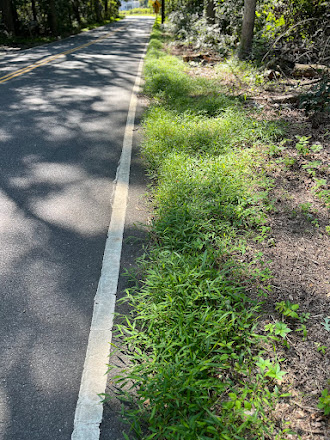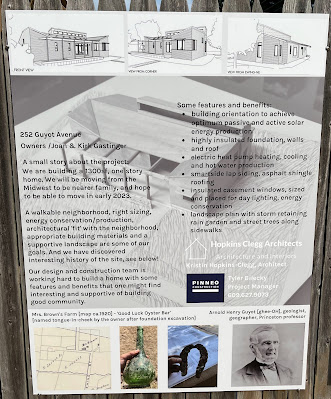This past November, I received a request to look at a lost forest in Princeton.
The request came from what may be the oldest open space organization in town--the Friends of Rogers Refuge.
Dating back to 1967, FORR has been working with the town, and the water company that owns the land just down from the Institute Woods, to sustain the refuge's role as premier habitat for a tremendous diversity of birds.
Over the years, I've been able to witness and collaborate with a progression of leaders who have overseen stewardship--the Southerlands, Tom Poole, the Spars, the Varians, and most recently David Padulo.
At annual meetings, discussions have tended to focus on the refuge's central feature, the surprisingly extensive marsh--how to keep it wet enough and protect it from the super-aggressive Phragmitis.
But this year, concern now extends to the floodplain woodlands surrounding the marsh--also vital bird habitat. One of these woodlands, thriving four years ago, has lost its trees.
This was not a forest classically lost to logging. The trees were not cut down but rather strangled over the course of several years, then left standing, each tree a monument to its past life.
Few have seen the now ubiquitous strangler, the Emerald Ash Borer accidentally introduced to the U.S. from Asia. It's larvae work quietly under cover of bark, feasting on the ash trees' circulatory tissues.
That a whole forest could die speaks to how common ash trees once were. The most numerous tree in Princeton up until just a few years ago, comprising more than 10% of the tree cover, the ash tree's skeletons can be found throughout the canopy of residential and open space lands. Ash were particularly good at colonizing abandoned fields, to the point of dominating one area of what is now Rogers Refuge.
As the botanist in an organization of birders, I was asked what the longterm prognosis for this lost forest might be. Winnie Spar, Joe Melton, and I walked the red trail to have a look.
One striking feature is what I call "poison ivy trees." These are dead trees, still standing, that have been scaled by poison ivy vines, with their classic "hairy is scary" stems. In order to bloom, poison ivy must climb a tree, sending out lateral flowering shoots along the way. The branch-like laterals give the tree the look of still being alive, even though all the leaves are now poison ivy. The flowers produce berries that, birders will enthusiastically tell you, serve as important food for birds.
Another feature of a lost forest is the shrub growth that now thrives on the infusion of sunlight previously claimed by the tree canopy. Much of this shrub growth, unfortunately, is nonnative and inedible to wildlife, like this Asian Photinia. At least it can be said that the invasive shrubs are not as thick at Rogers Refuge as they are at the Institute Woods just up the hill.
A few other native tree species fill a small portion of the void. In early November, the occasional silver maple and pin oak still had many of their leaves. Mixed in were a couple elms, and a red maple.
Used to the numerous red maples at Herrontown Woods on the other side of town, I was surprised to find instead an abundance of box elder of every size growing in this broad floodplain of the Refuge. Related to maples, box elder are not the most statuesque of trees, but their soft wood can make good bird habitat. They now stand as the main hope for rebound in this patch of former forest.

The walk being with such knowledgeable birders, attention never strayed far from bird life. We saw a couple pileated woodpeckers, a coopers hawk and a couple other larger hawks. Winnie kept up a running monologue about the status of this or that bird. Mockingbirds have been around for a long time, but the catbirds keep them out of their territories when they are present. While a warming climate is causing many birds to extend their ranges northward, ravens, surprisingly, are moving south. She's seen some in the Refuge. Warblers love something about the spicebush flowers, whether it's the flowers themselves or an insect in them. Blue gray knatcatchers were mentioned, along with many other bird names that didn't register in my botanical brain.
There's a lot of concern that last year's fires in Canada have been very hard on migrating birds that nest up there. A woman who catches and tags migrant birds had been having very few birds coming back down from Canada, but her catch/tag/release activity, conducted on Sundays, was hampered by rains every weekend this fall. One day she got only ten birds, total.
But then Winnie is quick to add that she saw Cape May Warblers in the Refuge for the first time, several in fact, with immatures, and they too nest in Canada. Winnie is one to accent the positive, while acknowledging that migrant bird numbers are down 50-90%.
This lost forest, the decline in bird numbers, accelerating changes in climate, democracy under threat--in many ways, America is losing its memory of what it once was. The soil, for its part, holds memory through the seeds that remain dormant within it. Back when the seed bank--this stockpile of seeds yet to sprout--was dominated by the seeds of native species, succession as an ecological phenomenon featured an orderly and predictable progression of species, from grassland to shrubland to mature forest. But the soil under our feet has lost its memory, whether by plow, development, intense browsing, or displacement of native species. Invasive lesser celandine, poisonous to wildlife, coats the ground in the spring, followed by inedible stiltgrass and its billions of seeds in late summer. Invasive shrubs and deer combine to limit native species and thwart the once timeless process of succession. Though the tree canopy is still dominated by natives, these are under increasing attack from introduced insects and disease.
Even healthy trees can be overwhelmed by vines of porcelainberry and wisteria.
Given the circumstances, it's fair to ask what sense there is in persevering. What I find is that the native growth force, if often smothered and badly abused, remains intact. When given a chance to prosper, native plants and wildlife still can thrive. In Rogers Refuge, we've seen a tremendous rebound of spicebush since the town began culling deer to reduce browsing pressure. That in turn has improved habitat for birds. FORR has paid contractors to successfully set back the Phragmitis and porcelainberry.
Through periodic interventions over a number of years, the Varians have virtually eliminated the one patch of invasive Japanese knotweed at Rogers Refuge.
We pick our spots, time our interventions strategically to have the most impact for the least amount of effort, and look for opportunities. Despite the tragedy of losing ash trees, the new openings in the canopy could potentially allow native shrubs to grow, flower and bear in ways they haven't since being shaded out decades ago.
Our inherited environmental mindset is that nature, if protected from intentional depredations like logging and draining, will heal itself. As FORR's webmaster Laurie Larson points out, "when
Charles H. Rogers and the Southerlands started birding the “Water Company” in the 60s and 70s it was a landfill." The initial fight was to put an end to dumping. But now, at Rogers Refuge and many other places, the main depredations (invasive species, climate change) are unintentional, and the healing must be helped along by intentional effort. That effort could seem a sacrifice, but the primary feeling is one of gratitude, for the chance to work with nature--the greatest and most generously creative collaborator of all.






































































